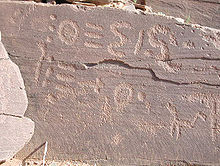Numidian language

The Numidian language, which is also known as Old Libyan, or simply Libyan is a language that was spoken in North Africa. Texts have been found from around the 3rd century BC to the 3rd century AD. While the writing system has been mostly deciphered, the language itself is unknown. Today, it is though to be an ancestor of the Berber languages. There are some texts that are multilingual (that is: the same text in more than one language). Despite this, the language itself is mostly unknown.
The script[change | change source]

Today, about 1200 texts are known, spread across North Africa. Many of the texts are from modern-day Tunisia, and the areas of Algeria, bordering Tunisia. In this large area, there are two main forms, an eastern form, occurring from Algeria eastwards, and a western form, occurring elsewhere.
- The eastern form is almost completely deciphered, and can be read. The meaning of 22 of the 24 symbols of the alphabet is known. The meaning was found because of a bilingual text (in Punic and Libyan) at the Libyco-Punic Mausoleum of Dougga.The mausoleum is in Tunisia, and dates from the 2nd century BC.
- The western form has more symbols, and cannot yet be read. There are 13 extra symbols, with unknown/disputed meaning. This variant is known as "Libyan-Berber script". As of 2021, about 100 texts are known. Most of them are short inscriptions on steles.
- There may have been a third form in the Sahara. Modern Berber languages probably developed from that third form. Modern Berber languages kept most of the writing system, which is called Tifinagh today.
People don't know if the two or three variants were the same language or different languages.
